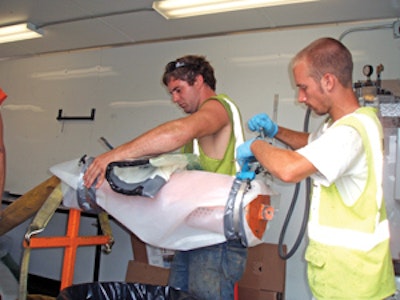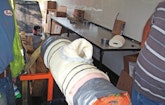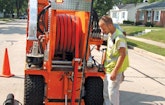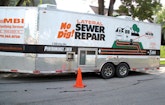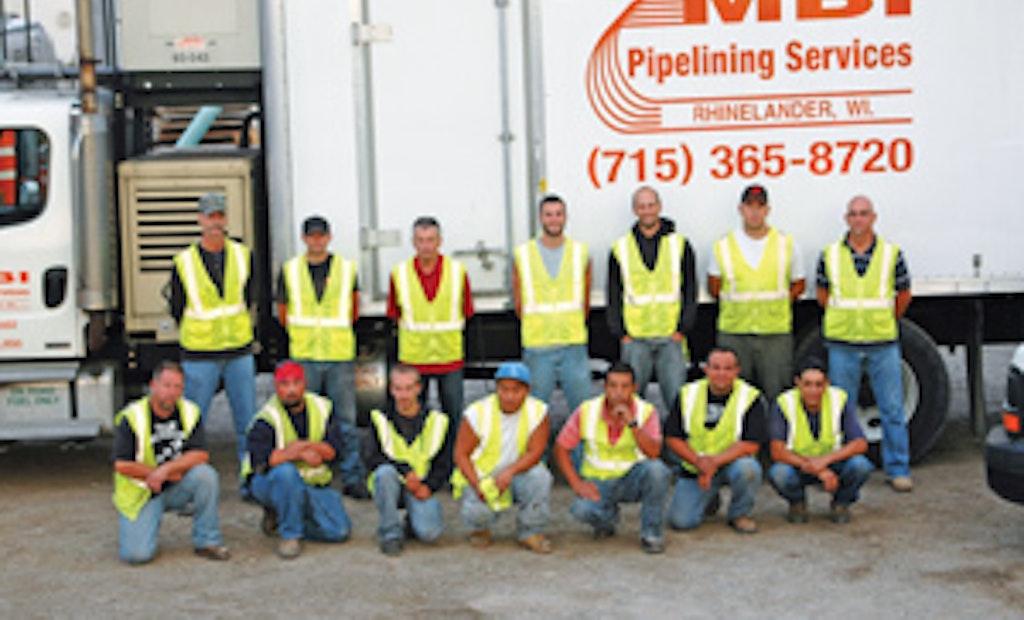Interested in Relining/Rehab?
Get Relining/Rehab articles, news and videos right in your inbox! Sign up now.
Relining/Rehab + Get AlertsPouring concrete and excavating building sites may seem like a far cry from lining sewer laterals, but for Musson Bros. Inc., the connection is more natural than it might appear.
The company made its name in Wisconsin as a grading and utility contractor and in a wide range of excavating jobs: clearing out new development sites and installing new sewer lines, to name just a couple.
But diversification has always been a prime value for the family-owned heavy-equipment company, based in Rhinelander, in the state’s Northwoods lake country. So when the opportunity arose to get into the trenchless industry, Musson decided to go for it – but with a specialty, niche-market focus.
Musson’s lining work focuses strictly on laterals. It was a lot to learn, but in the four years since the decision to enter the market, the company’s MBI Pipelining operation is going full-tilt. “This is just another aspect of being more diversified,” says Pipelining Division manager Pat Wunsch. “In these economic times it’s something else to have in your toolbox. And that’s really been the key to our success. It always seems when one aspect of your business is down, there’s another one that’s on the upside.”
Count the lining business as one of the upside specialties. Demand for the service is increasing, and the company is cautiously planning expansion in the coming years.
Diversification push
Wunsch credits Musson Bros. CEO and owner Tim Musson with moving the company into pipe lining. It was part of a big push to diversify after he succeeded his father in the mid-1980s. Tim Musson’s grandfather founded the business in 1947.
The lining business itself grew out of Musson’s work excavating and installing sewer lines. But like a beginning runner whose first race is a marathon, MBI took a more challenging route than some to enter the business. Instead of going the safe way – learning on mainlines and then graduating to trickier lateral repairs – Musson bypassed mainline work. “We went headfirst into a totally new industry that, frankly, I had very little knowledge of,” Wunsch says.
The company already knew the key contractors in Wisconsin that were performing mainline rehabilitation. It seemed to make more sense to find a proven lateral process that would complement the work of those contractors.
Wunsch was doing project management and estimation for Musson’s sewer and water main installation business when he learned about one cured-in-place pipe (CIPP) lining technology from LMK Technologies, manufacturer of the T-Liner and other lateral lining systems.
The technology’s benefits were obvious. Digging up and replacing a lateral can cost as much as $8,000, Wunsch notes; lining can bring the cost down to about $3,000. So with support from top management, Wunsch entered the business by hiring Jim Burnett, a project superintendent with pipe lining experience.
“It was pretty much a learning curve for him also,” Wunsch says. “He came from mainline lining. Laterals are a whole different animal.” One difference is the difficulty of getting access to most lateral lines. Another is the wide range of smaller pipe sizes used for laterals. And a third is the number of bends in laterals.
“With laterals you have very limited access for cleaning and inspection,” Wunsch says. “And to actually do the lining, you have to create an access point.” Working with LMK, MBI started as a subcontractor to an Illinois lining company on its first few jobs, working out of MBI’s offices in Brookfield, a suburb of Milwaukee.
In the real world
Becoming proficient took time. “It was a totally new technology,” Wunsch says. “On paper and in controlled environments, it looked very simple. In the field it was totally different. We went into our first job in Downers Grove, Ill., and hit it in a time of the year when we had a lot of inflow and infiltration from spring runoff. It was very challenging. There were a lot of learning situations on that first job.”
As MBI has gained experience, its territory has grown. The work began in Wisconsin and northern Illinois. “Pretty much at the start it was going where the work was,” Wunsch says. More recently, the company has had jobs as far away as St. Louis and Lower Michigan. It was a case of the right technology at the right time. But despite its advantages, lining doesn’t completely sell itself. “It’s been a lot of sales, marketing and educating people,” Wunsch says.
A big part of that effort has been seminars for wastewater system operators to show them how the lining systems work, complete with full-day hands-on training. MBI has conducted one a year for three years in a row. The last two years, the company collaborated with two other firms – distributor Envirotech Equipment Co., of Pewaukee, Wis., and a sewer inspection business called The Expediters based in Oconomowoc, Wis. – to put them on.
“It’s been very well received,” Wunsch says. Topics covered include manhole lining and lateral TV inspection, and there’s a live demonstration of lateral lining techniques. The sessions have drawn as many as 150 people, most of them municipal engineers.
“It’s free. We provide a light breakfast and a brown bag lunch,” Wunsch says. The state Department of Natural Resources has qualified the programs for required continuing education credits for system operators. Direct mail and e-mails to public works directors and city engineers help promote the programs.
Thanks to efforts like that, municipal engineers in Wisconsin and elsewhere are more aware of lateral lining. But because laterals are typically the financial responsibility of property owners, says Wunsch, “The biggest hurdle is, who’s going to pay for it?”
Tackling big jobs
MBI has put its name out to plumbing contractors, and some call with leads on jobs for property owners. Advertising fliers have been less effective than networking with plumbers.
Most work comes through large contracts with municipalities. In summer 2010, the City of Racine in southeastern Wisconsin hired MBI to line some 70 laterals. The city had agreed to cover the cost in return for a $50-a-year assessment on property owners’ sewer bills.
Jason Herzog, a civil engineer for the city, says Racine learned of MBI’s capability from an engineering consultant hired by the city. The consultant had recommended the LMK product line, and LMK in turn put the city in touch with MBI, whose employees demonstrated the system. The project was put out for competitive bids, and MBI was the winner.
At the work site, step one was to locate, inspect and clean the lateral lines. If there was no existing outside cleanout, workers hydroexcavated and installed a lateral access. Once the laterals were cleaned and measured, the work crew prepared and installed the lateral liner, pulling it into place through the main sewer line.
The liner is installed in an inversion process and uses a polyester resin. Once in place, the adhesive is cured with steam or ambient temperature. “We prefer to use steam curing, but we can do ambient,” Wunsch says.
A relatively new tool – both for inspecting the lateral and for giving work crews eyes to see the lateral liner as it is maneuvered into place from the mainline – is the Seeker pan-and-tilt push camera from Aries Industries. Wunsch says the unit gives multiple views inside the lateral. The lens can be self-cleaned because the camera can rotate 360 degrees inside its housing. “Another camera, if you get dirt on it, you have to bring it back to clean it,” he says.
“The key to lateral lining is to give them a good end product. And part of that is preparation. That’s why we require a camera inspection and cleaning access upstream, toward the house, to get in there and properly prep the lateral: cut the roots, if there are any, and if there are offset joints, address them. You don’t want to line over roots or mineral deposits.”
Investing in equipment
In building up its lateral lining business, MBI made a series of investments in new equipment. The biggest is a Vactor 2110 combination truck, originally bought for mainline cleaning and hydroexcavation, but now used for other purposes. For example, Musson grading crews use it to help with utility locating.
“We’ve actually taken on some storm sewer cleaning and televising jobs for other communities around here,” Wunsch says. “It was one of those pieces of equipment where I asked myself, ‘Do I make this quarter-million-dollar investment? How am I going to keep it busy?’ There’s no problem keeping it busy.”
MBI has two full LMK T-Liner installation rigs for laterals as well as a Launch Tank rig to line laterals going from the cleanout outward. In addition to the Aries camera truck, crews use a Mongoose trailer jetter and a truck-mounted jetter from Sewer Equipment Co. of America. An older SeeSnake push camera from RIDGID still gets plenty of use.
Lining up business
Wunsch sees a bright future for the operation. The current workload is “just the tip of the iceberg,” he says. As continued inflow and infiltration problems put pressure on sewer systems and lead to overflows, whether in Musson’s backyard market or across the country, demand for private property owners as well as municipal agencies to resolve the problems is likely to grow.
“Whether that involves a lining project, a grading project to get the water away from the house, or a sump pump installation program, it’s definitely a market that’s ready to take off,” says Wunsch. “And you’re seeing that all over the United States.”
And when it does, the MBI Pipelining Division plans to be on top of it.
